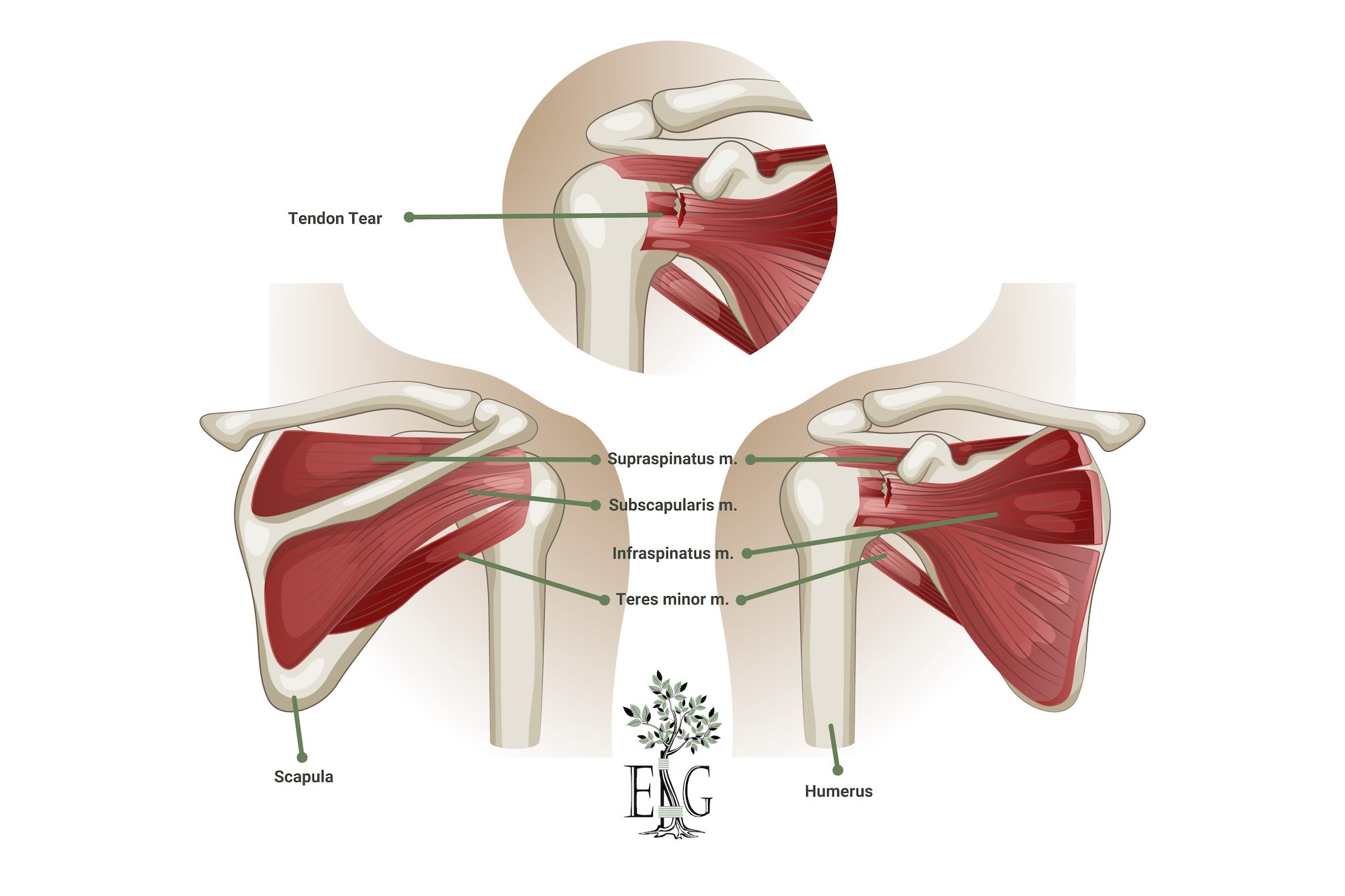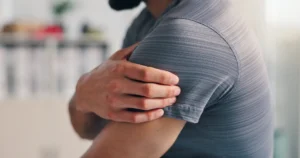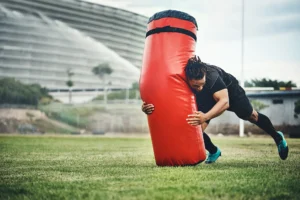Struggling with shoulder pain and arm weakness? You might have a rotator cuff tear. Understanding how to tell if you have a rotator cuff tear is crucial for addressing the issue early. This post highlights the symptoms to watch for, how a diagnosis is made, and what treatment options are available.
Key Takeaways
- Recognizing key symptoms of a rotator cuff tear, such as persistent shoulder pain, arm weakness, limited range of motion, and unusual joint sounds, is crucial for early intervention and treatment.
- Diagnosing a rotator cuff tear involves a comprehensive review of medical history, physical examination, and imaging tests like MRI or ultrasound to determine the extent and nature of the injury.
- Treatment for rotator cuff tears ranges from conservative approaches including physical therapy and activity modifications to more invasive methods like injections and surgical interventions, depending on the severity of the tear.
Understanding Rotator Cuff Tears
A rotator cuff tear can disrupt your daily activities, but understanding the basics of this condition is the initial step towards recovery. The rotator cuff consists of muscles and tendons that surround the shoulder joint, helping to stabilize the joint and allowing for various arm movements. These muscles and tendons are vital for preserving shoulder function and mobility. Think of it as the rigging that holds a ship’s mast steady amidst turbulent seas. When injury or wear causes one or more of these tendons to tear, it can result in a partial or full-thickness tear, either of which can significantly impact your shoulder’s function. Torn rotator cuffs are a common issue that many people face, and understanding the condition is crucial for proper treatment and recovery.

Most cases of rotator cuff tears happen in the supraspinatus tendon, but other parts of the cuff can also be involved in this injury. These injuries can manifest as a degenerative tear – a gradual fraying due to repetitive stress and diminishing blood supply – or as an acute rotator cuff injury from a sudden, traumatic event. Regardless of the type, the consequences are the same: compromised shoulder integrity and pain. Comprehending these tears’ nature is vital for identifying the symptoms and pursuing the right treatment.
Key Symptoms of a Rotator Cuff Tear
Like any medical condition, symptom recognition is vital. A rotator cuff tear declares its presence through a chorus of signs, including:
- Persistent shoulder pain
- Weakness in the affected arm
- Difficulty lifting or reaching
- Peculiar sounds emanating from your joint
Tuning into these symptoms can help you decipher whether you’re dealing with a minor strain or a significant tear that warrants medical attention.
Persistent Shoulder Pain
Shoulder pain that persists beyond the occasional twinge is like an off-key note that demands attention. It’s the most common early warning sign of a rotator cuff tear, often presenting as a dull ache deep within the shoulder. This pain may begin as mild discomfort during overhead activities, such as reaching into a cupboard, but it can advance into a sharp pain that intrudes upon your night’s rest, especially when you lie on the affected side.
Over time, the severe pain may become a constant companion, unresponsive to the usual over-the-counter medications. If your chronic shoulder pain is constant and worsens with certain movements, it indicates a need for professional intervention on your rotator cuff.
Arm Weakness
Arm weakness following a rotator cuff tear is akin to a loss of power in an engine – it hampers your ability to perform even the simplest of tasks. A sudden tear can lead to immediate weakness, accompanied by intense arm pain that radiates down your upper arm bone. Over time, chronic tears may result in a gradual decline in arm strength, causing pain and arm weakness, complicating everyday activities like:
- combing your hair
- reaching for a book on a high shelf
- lifting objects
- throwing a ball
- reaching behind your back
If you find yourself struggling with actions that once felt effortless, or experience discomfort reaching behind your back, consider it a red flag pointing towards a potential rotator cuff issue.
Limited Range of Motion
A clear indicator of a rotator cuff tear is when you are unable to execute simple movements – like raising your arm or reaching behind your back. This limitation often comes with a side of stiffness, adding an extra layer of discomfort to the affected shoulder.
If you observe a reluctance in your shoulder when attempting to stretch your arm out to the side or rotate it, it’s a strong indicator that something is amiss within the intricate network of your rotator cuff tendons.
Popping or Clicking Sounds
The soundtrack of a healthy shoulder should not include popping or clicking sounds. If you’re hearing a symphony of crackles and snaps during movement, it could be the telltale crepitus associated with a rotator cuff tear.
A grinding sensation or audible snapping when moving your arm is a sign that the smooth gliding of tendons has been disrupted, indicating potential damage to the rotator cuff. While these sounds may not always accompany pain, they are not to be ignored, as they can signify a tear that is changing the very mechanics of your shoulder joint.
Diagnosing a Rotator Cuff Tear
When discomfort and dysfunction become too significant to ignore, it’s time to seek professional diagnosis. Diagnosing a rotator cuff tear is a process that starts with a comprehensive review of your medical history and a discussion on how your symptoms are conducting your daily life.
This is followed by a physical examination and possibly imaging tests, such as MRI or ultrasound, to visualize the extent of the injury.
Physical Examination
During the physical examination, your orthopedic surgeon will conduct a detailed inspection of your shoulder from various angles, looking for any signs of swelling, atrophy, or asymmetry that might suggest a rotator cuff tear. They will palpate the tissues around the shoulder, seeking out areas of tenderness that may pinpoint the location of the tear.
The doctor’s skilled hands will also test your range of motion, noting any pain or discomfort with movement, as these can provide clues to the extent of the impairment.
Imaging Tests
To further investigate the hidden intricacies of your shoulder, imaging tests such as magnetic resonance imaging (MRI) or ultrasound are often employed. MRI scans excel at depicting the soft tissue structures of the shoulder, revealing the nature and severity of a rotator cuff tear with clarity. Ultrasound, on the other hand, provides a dynamic window into the movement of tendons and muscles, offering real-time insights as your shoulder goes through various motions.
While both imaging modalities are invaluable in confirming the diagnosis of a rotator cuff tear, they can also aid in crafting a tailored treatment score that resonates with your specific condition.
Treatment Options for Rotator Cuff Tears
Once a rotator cuff tear is diagnosed, the focus shifts to creating a treatment plan aiming to reduce pain and restore shoulder function. The selection of the treatment options, ranging from conservative approaches to surgical interventions, will strike a chord based on the severity and type of tear you’re facing.
Conservative Treatments
Conservative treatments initiate the healing process for a rotator cuff tear. These include modifications in daily activities, such as adjusting your workspace to minimize stress on your shoulder. Physical therapy exercises take center stage in this symphony of non-invasive treatments, working to enhance the flexibility and strength of the shoulder’s supporting muscles.
When pain flares up, applying ice or heat can serve as an immediate conductor to manage discomfort and inflammation, while a consistent regimen of shoulder strengthening exercises can prevent further injury.
Injections
For those seeking a respite from the persistent drumming of pain, corticosteroid injections can provide a temporary interlude of relief. These injections are adept at reducing inflammation, quieting the dissonant pain that can disrupt your daily life.
While not a long-term solution, corticosteroid injections can play a pivotal role in the comprehensive treatment score for a rotator cuff tear, allowing you to engage in physical therapy and strengthening exercises with less discomfort.
Surgical Interventions
In cases where the rotator cuff tear is more severe or conservative treatments fail to restore harmony, surgical interventions may take the stage. Arthroscopic surgery is often the preferred method, offering a less invasive approach with smaller incisions and the potential for a quicker recovery. However, some situations may call for open tendon repair, necessitating a more extensive incision to access and mend the damaged tendons.
For non-repairable rotator cuff tears, a reverse total shoulder replacement may be the best path forward.
Prevention Tips
Here are some tips to help prevent rotator cuff injuries:
- Perform routine strengthening exercises for the shoulder muscles.
- Use the correct technique during high-impact activities, such as throwing or lifting heavy objects.
- Ensure adequate rest and recovery between workouts or activities.
By following these tips, you can help keep your rotator cuff healthy and prevent injuries.
Strengthening Exercises
Incorporating strengthening exercises into your routine is critical to maintain the optimum performance of rotator cuff muscles and tendons. Here are some exercises you can try:
- Pendulum exercises: These exercises promote flexibility and enhance blood flow to the shoulder joint.
- External rotation exercises with resistance bands: These exercises fortify the external rotators.
- Scapular squeezes: These exercises bolster stability and posture.
Including exercises that target the following muscles in your conditioning program ensures that all the supporting players are ready for the spotlight:
- Deltoids
- Trapezius
- Rhomboids
- Rotator cuff muscles
Remember, using tools like elastic stretch bands can add versatility to your strengthening repertoire, and consistently engaging in these exercises 2 to 3 times a week can help maintain your shoulder’s strength and range of motion.
Proper Technique
Correct technique is the conductor’s baton that guides you through the complex movements of sports and repetitive overhead tasks. Ensuring that your elbow remains aligned with your shoulder during exercises can prevent undue stress on the rotator cuff. This alignment is key to minimizing the risk of injury, allowing you to perform with grace and precision without the fear of an unexpected finale.
Adequate Rest and Recovery
The rhythm of recovery and rest is as important as the intensity of your workouts. Giving your tendons enough time to recover between strenuous sessions is vital for preserving their health and avoiding overuse injuries.
A well-timed intermezzo of rest is not only restorative but can also enhance the effectiveness of your shoulder conditioning program, which should continue for about 4 to 6 weeks to ensure lasting benefits.
Summary
Whether through conservative treatments, such as physical therapy and medication, injections to reduce inflammation, or surgical interventions for more severe cases, the ultimate goal is to restore shoulder mobility and alleviate or eliminate pain. Understanding the symptoms and appropriate treatment options can help you regain function and improve your quality of life if you suspect a rotator cuff tear.
If you’re experiencing shoulder pain, limited range of motion, or weakness, it is important to seek a professional diagnosis to determine if a rotator cuff tear is the cause and to explore the best treatment plan tailored to your needs.
Frequently Asked Questions
What are the initial symptoms of a rotator cuff tear?
The initial symptoms of a rotator cuff tear include persistent shoulder pain, especially during overhead movements or at night, which may progress to sharp pain with certain arm movements.
Can a rotator cuff tear heal on its own?
A rotator cuff tear may improve with rest and physical therapy for minor tears, but larger or complete tears often require medical intervention for full healing.
What does a popping sound in the shoulder indicate?
A popping sound in the shoulder may indicate a torn rotator cuff, as it could be a sign of the tendons not moving smoothly. Consider consulting an orthopedic surgeon who specializes in shoulders for further evaluation and treatment.
How long does recovery from rotator cuff surgery take?
Recovery from rotator cuff surgery can take 4 to 6 months for shoulder function and strength to return, with full recovery potentially taking up to 12 to 18 months in some cases.
Are there exercises to prevent rotator cuff injuries?
Yes, performing exercises like pendulum swings, external rotation with resistance bands, and scapular squeezes can help strengthen the shoulder and lower the risk of rotator cuff injuries.





